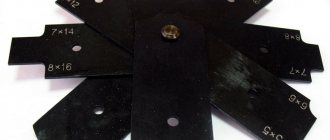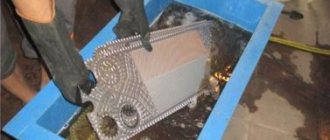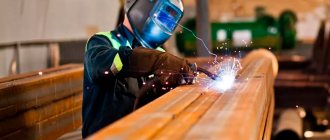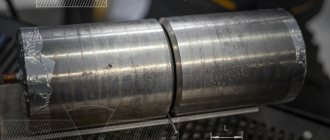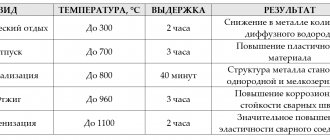Welding is a long-known method of fastening metal structures. It has many advantages, but there are also disadvantages, such that they can easily ruin all the work done previously. To minimize the impact of these shortcomings, various methods of protecting metal structures are used. Among them is weld processing. It is discussed further below.
What is the need for processing?
Welding affects the metal structures being held together more than it seems. At this moment, the parts develop a lot of internal stress. And because of it, they can become deformed and become more fragile, which leads to rapid destruction.
Welding also affects the chemical, physical and mechanical properties of metals, since uneven heating of parts during the bonding process leads to disruption of the crystal lattice of the material.
To restore lost properties to parts, processing is done at the bonding points. Stripping helps not only strengthen the structure, increase its ductility, but also protect welds from corrosion and rust.
Types of weld corrosion
After welding, the corrosion process can be external, internal or combined, which in its own way affects the appearance of the joint and deteriorates its characteristics. According to the type of corrosion there are:
- Solid
. It is divided into uniform (penetrates to the same depth throughout the entire upper layer) and uneven. Occurs in unalloyed metals and carbon steels. Rust covers the entire surface of the seam, so the connection deteriorates faster if nothing is done to protect it. - Local
. It appears in the form of spots, dots, ulcers in certain areas of the seam. Observed in Kh12MF steels and welding joints depleted of chromium. - Knife
. Has a thin line at the boundary between the weld and the base metal. It flows along the edge of the metal grains throughout the entire thickness, and not just from above, so this is a dangerous type of corrosion. Found on alloyed, austenitic steels and high-carbon alloys.
Methods for processing welds
Cleaning welded areas is a difficult process, requiring skills and sometimes complex equipment. The first thing you need to do whenever processing welded areas is to choose a method. There are only three main ones:
- Mechanical . It assumes that areas will be cleared with manual tools. Effectively removes scale.
- Thermal . Here you need heating and cooling according to a scheme selected according to the material of the part. It heats up either completely or only in the stripping area.
- Chemical . A compound is applied to the area that strengthens it and protects it from corrosion. Typically this method is used on those parts that are used in active environments.
It is impossible to say which method of cleaning welds after welding is the best, since each will be useful in some way.
There are often situations when all three methods are used sequentially on the same seam.
Body treatment after welding
» Articles » Body processing after welding
So this and the previous post were written late because I was on vacation
3 days after welding, I flew to treat the bottom and hidden cavities!
stocked up
2 bottles of bitumen rubber treatment and 2 bottles of Movil
I scrubbed the entire floor in the cabin with a brush
And flew off for processing
As always, my work began with dismantling the car) there were cracks in the roof and it was decided to weld them and strengthen them with iron from the inside
removed the 3rd door, cleaned the cracks, scalded them, scalded them from the inside
I came to work as usual to my friend Alexander santei-2110 and had to kick out his monster
17th sneakers and sketches of new arches (more details in his BZ he has already come a long way)
Lambo hinges as they are!
(if you need it we can make it to order!)
grinded the weld
put the door in place and treated it with Movilya
then Alexander began to process my car inside and out
The stench was terrible for about 5 days, I had to leave the windows open
I also had a trip of 800 km ahead of me on the front brakes alone, so I decided to change the pads that I had installed a YEAR ago, ferodo red pads
to put old pads on the edges from one wheel in the middle, new ones! I think that over the course of a year they have worn off very little! ! !
(I brake a lot and sometimes even at 140 I have to brake!)
these are my 2 helpers in pushing the piston back)
(one of them always travels with me just in case) ) )
Soon I’ll tell you about a trip of 800 - 1100 km on my basin with bolts
www.drive2.ru
Heat treatment
Thermal stripping is most often suitable for structures with thin walls, such as pipelines, reactor vessels, pressure vessels, etc.
The procedure will restore the strength of the material, reduce the effect of internal metal stress on the seams, and also ensure durability of the joints. And because of this, the entire structure will become more reliable. But all these benefits can be obtained if the work is performed by a specialist. After all, the slightest mistake will lead to defects that cannot be corrected. It is also important that high-quality tools are used during thermal stripping, however, they will be very demanding on energy, this will also need to be taken into account.
The technology itself for thermal stripping of seams assumes that the part will first be heated and then cooled in compliance with the correct temperature regime.
Heat treatment restores metal strength and improves joint properties
The heat treatment process involves first heating the area around the seam and the seam itself. The part remains in this state for a period of time (depending on the processing method), and then cools.
Heat treatment
Heat treatment of welded joints is considered a mandatory stage in the welding process of thin-walled products, especially those that are subject to deformation as a result of internal stresses.
Such products include a variety of containers, pipelines, pressure vessels, chemical and nuclear reactor vessels and other critical objects. The technology is based on heating and subsequent cooling of the welded part according to a strictly specified temperature schedule.
What problems does it solve?
During the welding process, only a small area of the joined elements is exposed to heat. Due to uneven heating, internal stresses arise in the seams, which are a significant reason for the deformation of parts and even their complete destruction. Also, in places where the metal is heated unevenly, the structure of its crystal lattice changes, which ultimately worsens the chemical and physical-mechanical characteristics.
Heat treatment of welded joints reduces the stress generated inside the welds and also allows:
- make the structure of the weld and heat-affected areas homogeneous and more resistant to external influences;
- improve the operational and physical properties of the metal: increase heat resistance and corrosion resistance, normalize ductility.
Heat treatment of welds restores the properties and structure of the metal and makes it possible to bring technical indicators to design solutions.
How does heat treatment work?
Heat treatment is carried out after welding at high temperatures varying between 600-1000°C.
The processing process occurs in the following order:
- The seam itself and the areas surrounding it on both sides heat up.
- In a heated state, the structure is maintained for a certain period depending on the method used.
- The part is cooled in accordance with the processing schedule.
For structures with different configurations and thicknesses, welding seams are processed in different ways, each of which has its own distinctive features.
Types of heat treatment
In practice, heat treatment of connecting joints obtained during welding is carried out in different ways. The table below lists the methods used and their features.
| Type of processing | Process Features |
| Preheat | The metal is heated to a temperature of 150-200 degrees. Used when joining parts made of low-carbon steel before welding and directly during welding |
| High holiday | Depending on the type of steel, the heating temperature is 650-750°C. After reaching the desired temperature for 5 hours, the mode is maintained at the same level. After treatment, the elasticity of the seam joint increases significantly, resistance to external loads increases, and stress decreases by up to 80%. |
| Normalization | This type of processing is performed at temperatures ranging from 950° and above. When heated to the required levels, a holding period occurs, after which the product is cooled under ambient conditions. The technique is used for products made of low-alloy and carbon steel grades. After the procedure, the tension decreases, the grain size of the material decreases, and the strength of the joint increases |
| Austenization | The method is based on hardening the joint seam by heating it to 1070° or more. It is necessary to warm up the joint for an hour, after which it is quickly cooled artificially. This method is used to perform heat treatment of welded seams of pipelines and other products made of austenitic steels in order to increase the elasticity of the joint. |
| Stabilization | With this type of annealing, the temperature is much lower compared to austenitization and the metal holding time is also shorter. |
| Thermal rest | Warming up to 250-300°C implies thermal relaxation of welded joints, when it is performed in the seam, the stress and level of diffuse hydrogen decrease |
Equipment selection
The joints obtained by welding are processed in several ways, for each of which a separate installation is used for heat treatment of welds:
- induction. Here you will need a high-frequency alternating current generator with sufficient power. An inductive coil wound over the treated area acts as a heating device;
- radiation _ It is performed by infrared radiation emanating from a heated nichrome wire. Electric current from powerful sources is passed through the wire. The technique can be used for materials with insignificant electromagnetic properties;
- gas _ In terms of energy consumption, the most economical method. Heating is carried out with a special burner, and it is important to correctly form the flame so that the area heats up evenly.
When choosing a suitable method, it is necessary to take into account the characteristics of the material, the thickness of the products, what problems the processing must solve and the economic factor.
Warm-up temperature control
Regardless of whether general or local heat treatment of the welded seam of pipes, containers or other products is carried out, in each case it is necessary to control the heating temperature. For this use:
- thermal paint and thermal pencil . These are chemical compounds that are applied to the joint and change color when the temperature changes;
- pyrometers and thermal imagers are electronic devices that operate remotely.
Thermal pencils and paints require continuous visual monitoring, and if temperature parameters deviate from acceptable values, surgical intervention is required. Thermal imagers and pyrometers are more accurate devices and can be integrated into an automatic system that maintains a stable temperature.
Pros and cons of heat treatment
The advantages of thermal treatment of connecting joints of metal products include:
- restoration of ductility and strength of the material;
- reduction of internal stresses;
- ensuring the durability of joints and the reliability of the entire structure.
Among the disadvantages are noted:
- increased requirements for the qualifications of specialists;
- the need for large and expensive equipment;
- if even minor errors are made, the processes are irreversible and it is impossible to correct the flaws;
- high energy costs.
Although there are shortcomings, if you follow the schedule and perform all the steps correctly, you can significantly improve the technical characteristics of the seams.
Areas of application
As a rule, improvement of seams by thermal methods is carried out in structures with increased operational requirements. This can be heat treatment of welded joints of process pipelines subjected to high loads of machine tools and mechanisms, and other structures operating in difficult conditions.
When carrying out body repair work, the treatment of car welding seams is often used by heating them to the required temperature.
Small products are heated in muffle furnaces. Larger structures are usually heated by induction or gas methods, in some cases by radiation. Corrosion protection of welds should be carried out as soon as possible after completion of the welding process.
Chemical treatment
Here, cleaning of welded areas will be carried out only by etching or passivation.
Seam etching is carried out before mechanical grinding. To do this, chemical compounds are used that create an anti-corrosion coating at the joints. Etching can remove oxidized nickel and chromium from metal structures, which will cause rust if left.
How etching agents are used depends on the size of the areas to be protected and the type of metal. This will affect processing time and whether the part will be completely covered in the etching solution or only a small portion will be covered.
Chemical treatment protects the metal from oxides and rust
Another method for cleaning welded areas is passivation. Here the compounds used, oxidants, will gently remove free metal from the surface, and then form a corrosion-resistant film.
However, passivation treatment uses strong reagents. Therefore, afterward, their residues must be washed off the metal part, and the water in which the washing was carried out must be properly disposed of.
The solution itself, which was used for passivation, will contain acids. It must be neutralized with alkali, then filtered, and then disposed of according to regulations.
We treat the car against corrosion on our own
Corrosion is when the surface of solids begins to deteriorate under the influence of chemical or electrochemical reactions or under the influence of the environment. It can appear on wood, plastic and concrete, and the metal from which cars are made begins to undergo this process already at the production stage of the vehicle.
This process continues during transportation and storage, but comes into full force during vehicle operation. Corrosion can completely destroy a car and turn iron into its oxide, which is popularly called rust. Many car owners mistakenly believe that once rust appears on the body surface, it is no longer possible to get rid of it and you just need to accept it and come to terms with it.
This is often due to simple ignorance of modern technologies, including ways to combat this phenomenon. In particular, anti-corrosion treatment of the car yourself or at a service center will help prevent property damage.
This method does not guarantee complete elimination of this phenomenon, but it significantly slows it down and helps maintain the vehicle in working order.
Causes of corrosion on a car
All vehicles without exception are subject to this, regardless of which manufacturer they were produced by. To a lesser extent, it affects cars produced in a single copy on a personal order. As a rule, they are subjected to anti-corrosion treatment at the first stages of production.
But even such measures are not able to completely rid the vehicle of this harmful phenomenon. With further operation of the car, especially in large cities and metropolitan areas, the process of destruction of metal by rust receives favorable conditions for its development.
The acceleration of corrosion is facilitated by small scratches and chips that a car can receive when driving on a poor quality road.
The vapors of reagents that are used to treat roads to prevent icy conditions help rust develop even more.
The rate at which corrosion develops depends on several factors. Among them:
- complexity of the body design and errors, both during the design and at the production stage;
- an insufficient layer of anti-corrosion treatment for hard-to-reach places in the factory, most often the bottom of the car suffers from this;
- improper care of the vehicle during its operation.
In recent years, the number of vehicles on the roads has been growing at an incredible rate. And as a result, the demand for body treatment preparations is constantly growing. They are divided into groups depending on the location of application and composition. But basically they are divided into preparations that need to be applied to external surfaces and preparations for hidden parts.
Modern do-it-yourself anti-corrosion treatment of a car is usually carried out with the following compounds:
External processing
- Bitumen mastic. This is a composition of synthetic and bitumen resins. It helps preserve areas damaged by rust and prevents the further spread of corrosion, acting as a protective film. The layer applied to the metal should not be thicker than 4 millimeters.
- PVC.
This material is made on the basis of rubber resins and is recognized as the longest-lasting protective material. But, as a rule, it can only be applied in the manufacturing plant. - Liquid plastic can also be used to treat car surfaces.
But due to its low resistance to mechanical stress, the use of such a protective material is not widespread.
Hidden surfaces and nodes
- Special non-drying compositions based on oils. This drug is constantly in a liquid state and is able to fill all microcracks that form on the surface.
- Special formulations based on paraffin or wax. After drying, the applied substance covers the surface with an elastic wax film. This anti-corrosion composition does not lose its elasticity even during sharp fluctuations in ambient temperature.
All these products can be purchased in specialized stores and the work can be done in a garage. Depending on what material you choose to use, you can maintain the integrity of your car for at least three years. It should be noted that anti-corrosion preparations are capable of forming a high-quality coating. They do not harm health because they do not emit toxic fumes.
And although such compositions are not toxic, you should take care of exposed skin and especially the mucous membranes of the body.
We begin the car processing process
Properly performed anti-corrosion treatment of a car with your own hands will not harm the car, because the layer of application of any component for protection must be of a minimum thickness. And its application to the body or assembly should be done extremely carefully. Before you begin measures to protect your car from corrosion phenomena, you should carry out preparatory measures:
- Free up space in the trunk and remove the sound insulation layer from it.
- Then remove the mats and insulation under the hood, that is, all coverings that can prevent you from reaching the body surface.
- Carefully remove any swollen paint and clean off any rusty areas.
- Rinse the car thoroughly, paying special attention to hard-to-reach areas. Professionals recommend washing your car before the upcoming anti-corrosion treatment in three stages with water at a temperature of at least 70 degrees. First, it will be enough to pour plenty of water on the car. After this, all areas should be thoroughly washed with detergents. And at the end, rinse the entire car thoroughly.
- Wipe the body dry to remove any remaining water with a soft cloth.
- The thresholds should be washed and dried especially carefully.
- Some rust preventatives can corrode rubber components, so remove any rubber that may be in contact.
- Cover the seats in the cabin with cellophane or thick rags so as not to accidentally stain them during the work.
- The pedals and the floor underneath them should also be carefully covered. The resulting coating is quite slippery and no one wants their soles to slide on the pedals.
Now you can begin preparing tools and materials for work. Regardless of the complexity of the repair, you will need:
- the anti-corrosion agent itself;
- drill or screwdriver;
- spray;
- paint brush;
- metal drill;
- simple plumbing tools
- rags;
- plugs for holes of different sizes.
In most cases, car owners carry out selective anti-rust treatment of those body elements that are most vulnerable to harmful influences - the underbody of the car and wheel arches. In addition, it is advisable to protect with an anti-corrosion mixture the places where moisture accumulates the most, such as the car pillars, its sills, welding points and joints on body bends.
https://www.youtube.com/watch?v=Ge1Tedca6lM
Complete processing consists of several stages. The bottom and wheel arches are subject to a two-layer application of the mixture. It is mandatory to treat hidden areas of the car, its welds and joints on bends. The surfaces inside the hood and trunk are treated in one layer.
After washing and drying the car, you can begin an analytical examination in order to identify defects on the external and internal planes. If scratches, chips or cracks are found, repair work should be carried out so that the treatment you carry out is not in vain.
Small scratches will need to be sanded down, but more serious damage will require additional care. They should be straightened, thoroughly cleaned, primed, puttyed and painted, and only after the surfaces become even and smooth can you begin to work with protective materials.
In those places and components of the car where access is difficult, the product should be injected directly through the existing holes for the factory fasteners. If there is no such hole, you can drill a new one, which, upon completion of the work, is closed with a special plug. You should be able to access all hidden areas and internal seams.
At the same time, try to use the existing holes to the maximum and only drill new ones in extreme cases.
Before you start working with the anti-corrosion mixture, carefully read the attached instructions. The features of its application and temperature indicators for the work are indicated there.
In order to process the underbody of the car, you will need to place it on an inspection hole and remove the wheels. It will not be superfluous to provide the work area with additional lighting.
Carefully process all surfaces, including welding areas, areas where bolts and other fasteners are located, go over the suspension and ball joints, and do not overlook the treatment of the thresholds.
To carry out work in hard-to-reach parts, you should use flexible nozzles, which are sold complete with anticorrosive. The use of an airless spray gun or paint brush when painting the bottom ensures uniform spraying of the product.
When you start working on the top of the car body, initially apply the mixture to the welds. Then you can start processing the joints of panels and elements, apply protection to fasteners, battery location, headlight mounting points and engine protection. Carefully ensure that the anticorrosive agent does not get on the generator, radiator honeycombs and drive belts, as this may cause the belt to slip or deteriorate engine cooling.
When working in the luggage compartment, carefully handle the seam located between the wheel arch and the rear fender. Next, you should process the transverse frame for the rear window along its inner side and the back of the lamp block, which will protect against oxidation of the contacts.
It should be noted that do-it-yourself anti-corrosion treatment of a car in the interior should be carried out just as carefully. First, you should treat the attachment points of the cross beams and seat brackets. Anti-corrosion material is sprayed onto the bottom seams of the opening and door frames. Work should be carried out with great care to avoid splashes on parts inside the cabin.
When you start processing doors, the danger may lie in the mechanisms themselves, audio and electrical wiring systems, the location of which is the doorways. Factory holes will help you avoid this. By inserting a nozzle into them, you will not be able to damage the wires with an awkward movement. If there are none, then you will have to drill new points.
When performing external processing, you need to apply the mixture to the weld seam at the bottom of the window opening. Door locks and existing seams are treated to protect the internal surface.
When all work is completed, you should wipe or rinse the mirrors and glass with water and special detergents dissolved in it. After this, you can begin to install in their places all the elements removed before starting work. After removing all the covers in the cabin, thoroughly wipe all surfaces of the panel, door handles, trunk and hood locks. Noticed stains of the anti-corrosion mixture are removed from the surfaces with a dry, clean cloth or rags.
Do-it-yourself anti-corrosion treatment of a car is considered complete
Of course, the work done will not give you a guarantee that doing this procedure just once will be enough. The coating will deteriorate over time and there will be a need to apply a new one. But carefully applied mastic will protect your car from corrosion for a long time. The service life of the anti-corrosion mixture will depend on many conditions, including the quality of the mixture used, compliance with the technological processes for its application, the initial condition of the car and its operating conditions.
The urgency of carrying out work to protect your car is explained by the speed of the process of destruction of metal by rust, which is facilitated by the increased humidity of air masses in certain regions and the use of chemical reagents on urban roads.
Nowadays, even when buying a car at a prestigious dealership, experts recommend treating the body with an anti-corrosive agent. This is due to the fact that not all manufacturers pay due attention to this important issue. And car owners have to do the treatment themselves or at a car service center.
However, not everyone can afford to entrust this work to service technicians, because this is a rather expensive procedure, and, again, no one can vouch for the quality.
Kolodiychuk Andrey
, especially for ByCars.ru
Source: https://bycars.ru/journal/obrabativaem-avtomobil-ot-korrozii-svoimi-silami_1626
Safety precautions
Cleaning of welded seams can only be done in a special form, in compliance with all safety regulations. So, when working with chemicals, protect your hands, respiratory organs, and eyes.
Note!
Such work is carried out by a specialist with education and skills, over 18 years of age.
Welded areas are protected, as these are one of the most fragile areas of any metal structure. And if they can be strengthened, it is worth making every effort to ensure that the welded structure lasts as long as possible. For this purpose, there are methods for cleaning welds described in this material.
Purpose of seam sealants
Welded seams require additional protection so that the metal structure lasts longer and negative processes do not occur on the material, for example, corrosion does not appear. The purposes of sealants are as follows:
- Waterproofing layer for seams or base;
- Closing cracks and gaps;
- Repair work on planes with flaws and cracks.
The products differ in the level of shrinkage following curing. Having treated the metal with the composition, there is no need to be afraid that vibration effects will affect the integrity of the seam; the layer can stretch and bend. The product is used for pipelines, heating systems, in parts of various devices and for other items, depending on the chosen type.
When welding channels, high-quality electrodes are used. In this case, the drawings should be carried out in accordance with the ESKD, after which additional processing of the seams is also sometimes used.
Welds require additional protection to ensure that the metal structure lasts longer.
Criteria for choosing joint sealant
Various types of sealants are created for cars: for the body, pipe joints, hatches. The differences between the compositions lie in the degree of heat-resistant, elastic properties, and durability of the processing result. The most effective are considered to be professional types, which are sold in large volumes, and it is advisable to take them for auto repair shops when a lot of similar work is carried out.
For independent one-time processing of welding seams, it is advisable to purchase small tubes of 40-200 grams. If you take a similar type, then it is advisable to leave the choice on an aluminum tube; the container allows you to maintain the technical characteristics without changing the entire shelf life.
The plastic option is cheaper, then you should use a sealant if its shelf life lasts at least six months.
There are options for sealants on sale, with a provided tip, which can be used to fill welding seams and corners conveniently. Body sealant in cartridges can only be applied using a special gun.
The differences between the compositions lie in the degree of heat-resistant, elastic properties, and durability of the processing result.
Sealant application technology
The use of sealant for a car has certain requirements. You need to know the operating rules described below:
- First, the base must be cleaned of all types of contaminants, including removing rust and degreasing the base;
- To increase the degree of adhesion, stripping is carried out with red Scotch Brite;
- A primer solution for metal surfaces is applied when such a step is indicated in the instructions for the sealant;
- Prepare the composition, place the tube in the gun, open the tape, or prepare a brush or spatula for applying the product;
- The product is distributed at the same speed and preferably in one go, so that the seam comes out optimally even.
The excess part of the layer is removed immediately with a spatula or simply with a gloved finger. If the layer is excessively sticky, sprinkling with water will reduce the problem. The layer can be painted after the time indicated on the packaging.
The product is distributed at the same speed and preferably in one go, so that the seam comes out optimally even.
